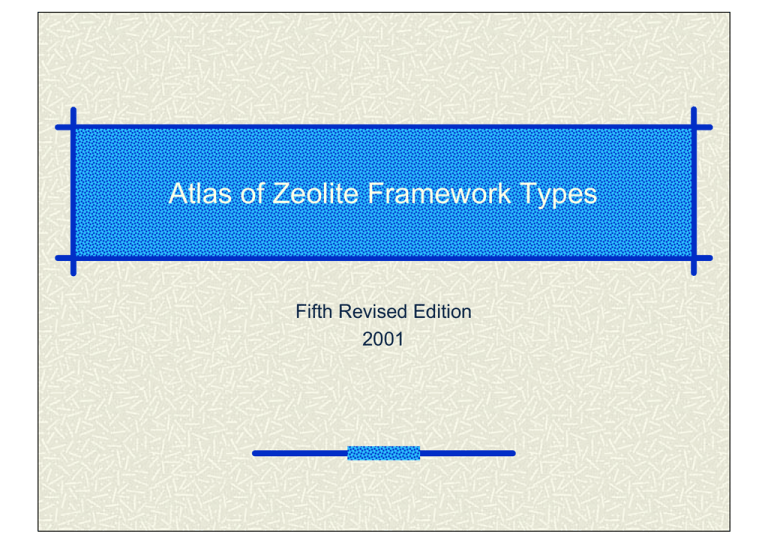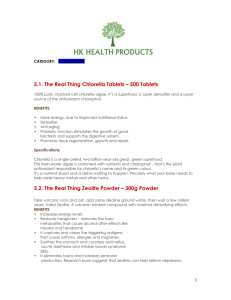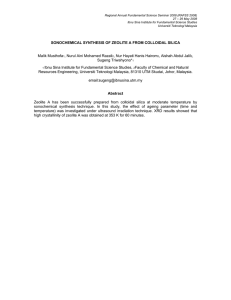Atlas of Zeolite Framework Types
advertisement

Atlas of Zeolite Framework Types Fifth Revised Edition 2001 Summary Introduction Books of the International Zeolite Association (IZA) Availability History of the Atlas of Zeolite Framework Types Organisation of the Atlas Explanatory Notes from the Atlas of Zeolite Framework Types Examples LTA LTL Other framework types (if appropriate) 2 Introduction International Zeolite Association (IZA) Books from the Structure Commission 3 Introduction Availability Printed Version www.elsevier.com Electronic Version (pdf-Files) www.iza-online.org 4 Introduction History of the Atlas of Zeolite Framework Types Edition Year Zeolite Structures 1st 1970 27 2nd 1978 38 3rd 1982 85 4th 1996 98 5th 2001 133 5 Introduction History of the Atlas of Zeolite Framework Types Change of name for the Atlas recommended by IUPAC in 2001 Old : Atlas of Zeolite Structure Types New : Atlas of Zeolite Framework Types - Structure: Implies both, the framework and extra-framework constituents - Framework: Corner-sharing network of tetrahedreally coordinated atoms 6 Introduction Organisation of the Atlas Two pages in the Atlas for each framework type code Left page Framework Type Informations Framework type code Stereographic figure Idealized cell constants Coordination sequences Vertex symbols Secondary building units Loop configurations of T-atoms Framework description Isotypic framework structures References Right page Type Material Informations Crystal chemical data Framework density Channels (observed rings) Stereographic figure (channels) 7 Left Page Framework Type Informations 8 Notes and Examples Framework Type Code Previously called Structure Type Code Three capital letters (IUPAC Commission on Zeolite Nomenclature, 1978) Usually derived from the name of the type materials (Appendix D in the Atlas) For interrupted frameworks the 3-letter code is preceded by a hyphen (-) For intergrown materials, the * denotes a framework of a hypothetical end member Code Abbreviated Name Full Name LTA LTL FAU MFI -CLO *BEA Linde Type A Linde Type L Faujasite ZSM-5 (five) Cloverite Zeolite Beta Zeolite A (Linde Division, Union Carbide) Zeolite L (Linde Division, Union Carbide) Zeolite Socony Mobil – five Four-leafed clover shaped pore opening 9 Notes and Examples Framework Type Code Codes are only assigned to established structures that satisfy the rules of the IZA Structure Commission (Rules can be found in Appendix B) The codes should not be confused or equated with actual materials. They only describe and define the framework Not allowed: NaLTA, NaLTL, NaFAU Correct is to use: | | for guest species, [ ] for framework host |Na+12(H2O)27|8 [Al12Si12O48]8-LTA or |Na| [Al-Si-O]-LTA |K+6Na+3(H2O)21| [Al9Si27O72]-LTL or |K-Na| [Al-Si-O]-LTL |Na58| [Al58Si134O384]-FAU or |Na| [Al-Si-O]-FAU Framework types do not depend on composition, distribution of the T-atoms, cell dimensions or symmetry (T-atoms: Si, Al, P, Ga, B, Be, etc.) 10 Notes and Examples LTA: Structure and Framework Figures 11 Notes and Examples LTA Framework: Stereographic Figure 12 Notes and Examples LTL: Structure and Framework Figures 13 Notes and Examples LTL Framework: Stereographic Figure 14 Notes and Examples Idealized Cell Parameters They are obtained after geometry refinement in the highest possible symmetry for the framework type Refinement was carried out assuming: Hypothetical SiO2 composition dSi – O = 1.61 Å dO – O = 2.629 Å dSi – Si = 3.07 Å Crystal System Space Group Cell Parameters LTA Cubic Pm-3m a = 11.9 Å LTL Hexagonal P6/mmm a = 18.1 Å c = 7.6 Å 15 Notes and Examples Coordination Sequences (CS) Each T-atom is connected to N1 = 4 neighboring T-atoms through oxygen bridges These neighboring T-atoms are then linked in the same manner to N2 T-atoms in the next shell Each T-atom is counted only once Infinite, ideal case without T-atom sharing: N0 = 1 N1 = 4 N2 = 12 N3 = 36 N4 = 108 Listed in the Atlas for every T-position: Multiplicity and site symmetry of the position CS from N1 up to N10 16 Notes and Examples Coordination Sequence for LTA T1 (24, m) 4 9 17 28 42 60 81 105 132 162 17 Notes and Examples Coordination Sequences for LTL T1 (24, 1) 4 9 17 29 46 69 … T2 (12, m) 4 10 21 35 49 66 … 18 Notes and Examples Vertex Symbols The vertex symbol indicates the size of the smallest ring associated with each of the 6 angles of a tetrahedron (T-atom) The symbols for opposite pairs of angles are grouped together Rings of the same size at a vertex are indicated by a subscript LTA T1 4.6.4.6.4.8 LTL T1 T2 4.4.4.6.6.8 4 . 83 . 4 . 83 . 6 . 12 19 Notes and Examples Vertex Symbol for LTA 4.6.4.6.4.8 20 Notes and Examples Vertex Symbols for LTL 4.4.4.6.6.8 4 . 83 . 4 . 83 . 6 . 12 21 Notes and Examples Secondary Building Units (SBU) Zeolite frameworks can be thought to consist of component units: Finite (i.e. chain-like) Infinite (i.e. layer-like) The finite units which have been found to occur in tetrahedral frameworks are called Secondary Building Units (SBU) The primary building units are TO4 tetrahedra SBU are derived assuming that the entire framework is made up of one type of SBU only If more than one SBU is possible, all are listed Number in ( ) = frequency of occurrence 22 Notes and Examples Secondary Building Units for LTA 8 or 4-4 or 6-2 or 4-2 or 4 23 Notes and Examples Secondary Building Units for LTL 8 or 6 24 Notes and Examples Loop Configuration of T-atoms Simple graph showing how many 3- or 4-memberd rings a given T-atom is involved in Can be used for classification purposes Information given is a subset of the vertex symbol Solid lines: T – O – T link Dotted lines: T – O bond found in interrupted frameworks Number in ( ) = frequency of occurence 25 Notes and Examples Loop Configuration of T-atom for LTA 26 Notes and Examples Loop Configuration of T-Atoms for LTL 27 Notes and Examples Framework Description For all 15 framework types of the so-called ABC-6-family the ABC stacking sequence is listed AFT Listed are also some other structural relationship which are thought to be helpful FAU 28 Notes and Examples Isotypic Framework Structures As-synthesized materials that have the same framework type but different chemical composition Materials with different laboratory code Materials obtained by post synthesis treatment (e.g. in exchange, dealumination) are generally not included The type material, the species first used to establish the framework type, is given first and marked with an asterisk LTA LTL 29 Notes and Examples Zeolite Type Categories and Framework Type Groups Zeolite type categories Silicates Phosphates Framework type groups Silicates Phosphates Both, silicates and phosphates 30 Notes and Examples References Is not a complete list As general rule, references are given to: Work to type of materials first establishing that framework type Subsequent work adding significant information regarding the framework topology References to isotypes are limited to the work in which sufficient data are provided to establish the identity 31 Right Page Type Material Informations 32 Notes and Examples Crystal Chemical Data Composition, expressed in terms of cell contents (New IUPAC rules are used) Crystal system, space group and cell parameters Relationship of the unit cell orientation with respect to the framework type, if the space group setting of the type material differs from that of the framework type 33 Notes and Examples Framework Density (FD) The framework density is a simple criterion for distinguishing zeolites and zeolite-like materials from denser materials Definition: Number of T -3 Atoms 1000 Å The figures given refer to the type materials Non-zeolitic framework structures: FD = 20 – 21 Zeolite with fully crosslinked frameworks: FD = 12.1 – 20.6 FD’s less than 12 have only been encountered for the interrupted framework of cloverite (-CLO) The FD is obviously related to the pore volume but does not reflect the size of the pore openings 34 Notes and Examples FD vs. Smallest Ring in Loop Configuration The + sign indicates that there are some T-positions associated with only larger rings LTA Smallest ring size: 4 FD = 12.9 LTL Smallest ring size: 4 FD = 16.3 MFI Smallest ring size: 4+ FD = 17.9 35 Notes and Examples Channels Short notation for description of channels Channel direction, relative to the axis of the type material structure <. . .> : All symmetry related directions [. . .] : Only given direction ⊥[. . .] : Channel direction is at right angle to the given direction Number of T-atoms forming the ring (in bold type) Free diameters of the channels in Å Number of asterisks (*): Channel is one- two- or three-dimensional Double arrow (↔): Interconnecting channel systems A vertical bar ( | ): No direct access frome one channel system to the other 36 Notes and Examples LTA: Channel <1 0 0> 8 4.1 x 4.1 *** 37 Notes and Examples LTL: Channel [0 0 1] 12 7.1 x 7.1 * 38 Notes and Examples OFF (Offretite): Channels [0 0 1] 12 6.7 x 6.8 * ↔ ⊥[0 0 1] 8 3.6 x 4.9 ** 39 Notes and Examples RHO (Zeolite Rho): Channels <1 0 0> 8 3.6 x 3.6 *** | <1 0 0> 8 3.6 x 3.6 *** 40




